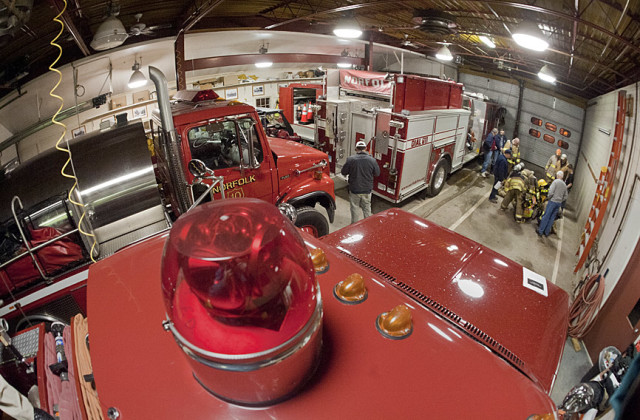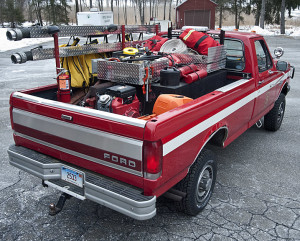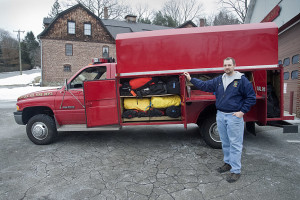Board of Finance Hears Fire Department Funding Request
Sconyers Calls for More Regional Coordination
By Wiley Wood
On January 13, at a regular meeting of the Board of Finance, the Norfolk Volunteer Fire Department (NVFD) presented a request for $125,000 to replace an aging utility truck. Michael Sconyers, chairman of the Board of Finance, expressed his unwillingness to raise taxes or borrow money for that purpose and queried whether the fire department should scale back its operations.
The utility truck, which must conform to National Fire Prevention Association codes, carries equipment and personnel to the scene of an incident, including a Stokes litter, cold-water and rope-rescue equipment, airpacks and hazmat supplies. The firefighting fleet also counts three pumpers, a tanker, a communications trailer and a Utility Terrain Vehicle.
Ludwig said that the oldest pumper in the fleet, a 1985 Pierce, has reached the 30-year mark and would also need replacement soon, at a cost of about $300,000.
Referring to the pumper trucks, Sconyers asked, “Why does it take three trucks, why can’t you do it with two?”
The explanation provided by Ludwig and NVFD First Lieutenant Steven Hutchins is that fire hydrants are few in Norfolk and that the closest water source to a fire can be a long way off. Where the distance is less than a mile, the Norfolk firemen lay hose the whole way, from a pumper truck sucking water from a pond at one end to an attack truck pouring water on the fire at the other, with a relay pumper in the middle to maintain water pressure. At distances greater than a mile, the first pumper fills a tanker truck, which ferries the water to a site near the fire and dumps it into an artificial pond, essentially a collapsible, above-ground pool, from where the second pumper relays it to the attack vehicle.Ludwig pointed out that the town has bought a replacement pumper truck roughly every ten years for the last six decades, a schedule that allows the oldest pumper to be retired after 30 years. He argued that the periodic request from the fire department should be counted into the town’s fiscal planning.
“I just find it hard to believe, guys, that comparable towns with less than 1,700 citizens living in them have all got this kind of equipment,” said Sconyers. “They do,” said Ludwig, citing the towns of Colebrook, Canaan, Cornwall and Goshen.
Sconyers raised the question of whether Norfolk’s firefighting needs could be partly supplied by mutual aid, to which Ludwig and Hutchins responded that they are. “Every time there’s a structure fire or a chimney fire in Norfolk, Canaan’s ladder truck is automatically called out,” said Ludwig. And Norfolk contributes in turn, having sent a tanker just the previous night to the Northeast Building Supply fire in Cornwall. But he went on to say that mutual aid is meant to assist a town in fighting a fire, not to provide primary capacity.
“I’m just having a hard time funding something that’s used so infrequently at such a high expense without a comprehensive plan for the whole district,” said Sconyers. “This is the debate we’re having about the schools,” he went on, “we can’t be independent any more. We have to have a better system.”
In the event, Sconyers appointed two members of his board, Jeff Torrant and Graham Allyn, to make an independent analysis of the fire department’s needs.
The NVFD receives an operating budget from the town of $80,000 to $90,000 a year, and in 2015 the town will make its final $75,000 payment on the loan for Engine 40, a pumper truck bought in 2009. The town also pays about $40,000 yearly into an incentive program for emergency services volunteers, firefighters and ambulance corps combined. The town’s total budget is about $7.5 million.
“Right now we can fight fires anywhere in Norfolk,” says Ludwig. “What we worry about is what happens in the next five years when Engine 90 doesn’t get its DOT certification. How are we going to ensure people’s lives and property?”
First Selectman Sue Dyer approves of the level of service provided by the NVFD, “The Board of Selectmen understands the department’s need and supports their need, at the same time recognizing that it’s up to the Board of Finance to decide how to go about it.”
An unedited video of the January Board of Finance meeting is available on RobinHoodRadioTV by clicking here.
Photos by Bruce Frisch.




In this day and age I am still baffled by the sheer ignorance resonated by politicians, especially in the capacity of finace, when it comes to the funding of and the understanding of their local fire and emergency services. It disgusts me more that elected officials (even just one) have not once taken the time to invest time to learn firsthand about their local volunteers’ needs, the state and national standards the department must adhere to (ISO ratings, annual training, equipment replacement, etc.)
Yes, money does not grow on trees. Yes, even for volunteer departments, routine operating costs have risen leaving members having to hold fundraisers because their town refuses to stand alongside them and help bear this burden. No one wants higher taxes, but if a town refuses to open their minds to some sort of investment program where X amount of dollars goes into a yielding account for such occasions, then taxes are it’s end-game.
Fire Departments are not here to rob towns of their money, fire departments are here to protect us and our property. Departments need to be as self sufficient as possible, no matter how rural their area and no matter how low their call volume is. It takes only one minute to activate mutual aid, but it takes much longer for that help to arrive. In that time it’s the local department’s job to do a such they can with as few members are present. So explain to me why the Board of Finance should shortchange the very entity protecting it?